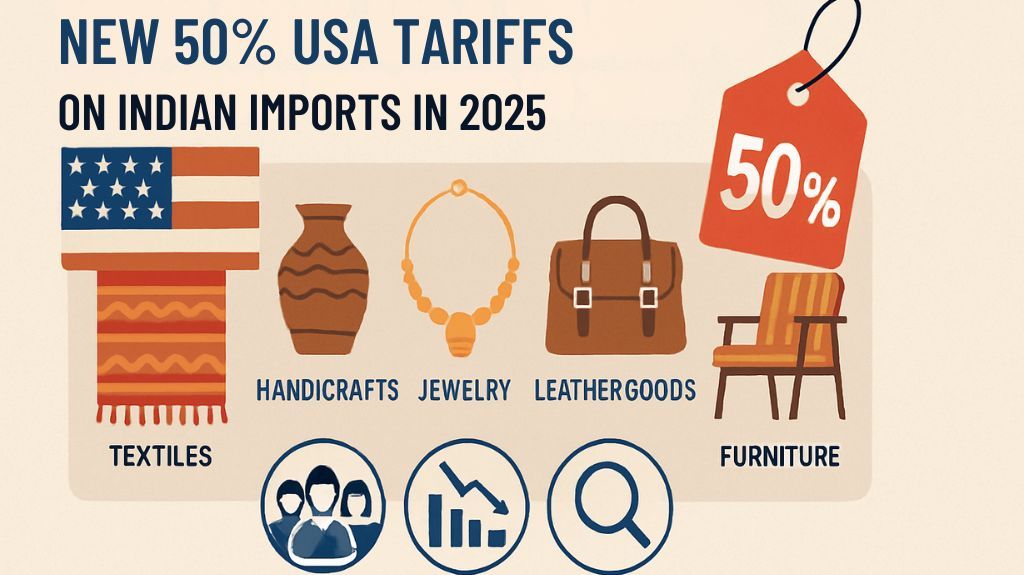Global trade continues to evolve, and one of the biggest challenges international buyers face today is navigating USA tariffs on Indian imports. Whether you’re sourcing handicrafts, leather goods, furniture, or home décor from India, understanding tariff policies is crucial to staying profitable in 2025.
Why Are Tariffs Important?
Tariffs are additional duties imposed by the importing country (in this case, the USA) on goods coming from other nations. For global clients, tariffs affect pricing, profit margins, and supply chain decisions. Even a 5–10% duty hike can significantly change the landed cost of your product.
Current Scenario in 2025
- The USA has maintained or adjusted tariffs on certain categories of Indian exports, including textiles, leather accessories, and industrial products.
- Categories like handicrafts and eco-friendly décor often remain competitive due to exemptions or lower duty rates.
- Trade talks between India and the USA continue to evolve, but global buyers must plan for uncertainty.
What Global Buyers Should Do
1. Understand HS Codes & Product Categories
Each product has a Harmonized System (HS) code, and tariffs vary by category. Before sourcing, check the exact duty percentage applicable to your product. This avoids surprises at customs.
2. Calculate Landed Cost Early
Instead of focusing only on factory prices, include tariffs, shipping, and logistics charges in your cost planning. This gives you a realistic profit margin before placing bulk orders.
3. Diversify Your Product Mix
If certain product categories face high tariffs, balance them with low-duty or duty-free items. For example, combine metal handicrafts, eco-products, or decorative items with higher-duty goods to spread risk.
4. Negotiate Better with Suppliers
Global buyers can negotiate FOB (Free on Board) terms, bulk discounts, or packaging efficiencies to offset tariff costs. Experienced India sourcing agents, like Panoramic Sourcing, help clients secure competitive deals.
5. Consider Alternative Shipping & Trade Routes
In some cases, using third-country logistics hubs or bonded warehouses can help manage tariff impacts more effectively.
6. Work with a Trusted India Sourcing Partner
A reliable sourcing agency in India can guide you on tariff-friendly categories, supplier compliance, and best shipping practices. This ensures you stay competitive despite duties.
Why Still Source from India?
Even with tariffs, India remains a cost-effective, high-quality sourcing hub for global clients. Indian products—especially handicrafts, home décor, leather goods, and sustainable items—offer unique value that often outweighs tariff costs. Plus, India’s skilled artisans, ethical manufacturing, and diverse product base continue to attract Amazon FBA sellers, retailers, and wholesalers worldwide.
Final Thoughts
USA tariffs on Indian imports in 2025 are a reality global buyers must adapt to. The key is not to panic but to plan smarter. By understanding duty structures, diversifying your product mix, and working with an expert India sourcing partner like Panoramic Sourcing, you can protect your margins and continue to grow your business confidently.
FAQs on USA Tariffs on Indian Imports
1. Are Indian handicrafts tariff-free in the USA?
Most Indian handicrafts face low or minimal tariffs in the USA, making them highly competitive. However, duties may vary based on material (metal, wood, ceramic, textile), so it’s important to check the HS code of each product.
2. How do USA tariffs affect Amazon FBA sellers sourcing from India?
For Amazon FBA sellers, tariffs directly impact the landed cost of goods. A higher duty means reduced profit margins unless factored into pricing. Sellers should calculate tariffs before importing and adjust their Amazon selling price accordingly.
3. Which Indian products are most affected by US tariffs?
Products like textiles, leather accessories, and some industrial goods often face higher tariffs. On the other hand, eco-friendly décor, handicrafts, and unique artisan products usually attract lower duties.
4. Can sourcing agents in India help reduce tariff impact?
Yes. A sourcing agent like Panoramic Sourcing can guide clients toward low-duty product categories, negotiate with suppliers for better prices, and advise on packaging/shipping strategies to optimize landed costs.
5. How can global buyers calculate the exact tariff for their product?
Every product has an HS (Harmonized System) code that determines its duty rate. Buyers can check the USITC (United States International Trade Commission) database or work with their sourcing partner to know the exact tariff before importing.
6. Should global clients stop sourcing from India due to tariffs?
No. Despite tariffs, India offers competitive pricing, craftsmanship, and unique product designs that are hard to replace. Smart planning, negotiation, and diversification help global buyers stay profitable while sourcing from India.

